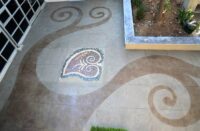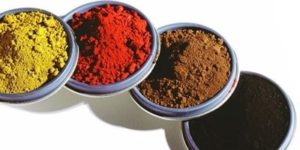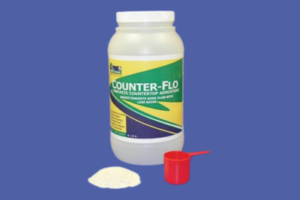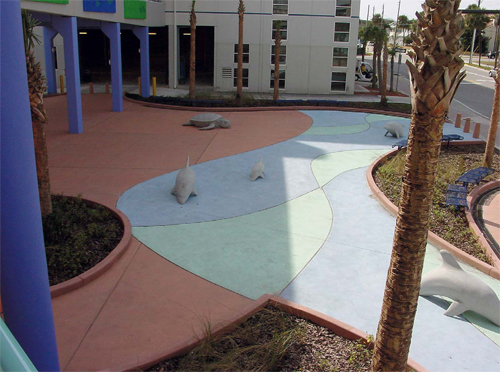
When it comes to colored concrete, the industry standard tends toward rich coloring that implies depth – a finish that draws the eye – and there are plenty of examples of colored concrete that achieve that standard.
Unfortunately, there are also instances in which the coloring process appears to have gone horribly wrong: a mottled look, a faded or dull appearance, or blistering and delaminating of stains or dyes.
Why do some concrete pours result in the desired appearance while others fall short?
Most contractors know that water is the guiltiest of parties when it comes to faded integral colors. More water equals less vibrant color… always. But water isn’t the only culprit when it comes to unsatisfactory integral color.
“In general, anything you add to a concrete mix can and will affect the color of integral concrete,” says Chris Sullivan, vice president of sales and marketing for ChemSystems Inc., a manufacturer of decorative concrete additives. “With additives, color change can range anywhere from very slight to quite dramatic.”
Admixtures allow contractors to manipulate the chemistry of a concrete mix. With admixtures, contractors can reduce the water ratio in a batch, speed up set time, or create a super-strong or maybe a more porous concrete. But what effect can admixtures have on the color of concrete?
Mixed Results: Admixtures and Their Effects on Color

Accelerators
Accelerators are used to reduce the set time of concrete and increase early strength gain. Speeding up set time allows contractors to pour concrete in cold temperatures and can also increase efficiency by reducing the amount of time a crew spends finishing. Unfortunately, the most commonly used accelerator, calcium chloride, is the admixture that has the most catastrophic effect on integral color.
“Calcium chloride is by far the most detrimental admixture to concrete coloring,” says Dionne Ojeda, national sales manager for Fritz-Pak Corp. “It doesn’t disperse well into the concrete mix. It tends to clump and ball up, resulting in a mottled look in integrally colored concrete. Unfortunately, calcium chloride is the accelerator of choice for most ready-mix companies. It’s cheap, readily available, and it works well.”
The chloride ion – one element of calcium chloride – is a very aggressive chemical, Sullivan says. “It attacks pigment and it’s sometimes hard to control the concentration. The blotchy look you get with calcium chloride is a result of uneven distribution of the chloride in the batch.” Calcium chloride even has a damaging effect on acid stains and dyes, says Rick Smith, president of Richard Smith Custom Concrete, a Canoga Park, Calif., contractor. “It tends to repel stains and you end up with blistering or delaminating over time. With dyes the problem lies in the clumping aspect – calcium chloride tends to draw water to itself, even years after the concrete has been set. Because of that, even with a dye, you end up with darker areas where the chloride has clumped.”
So what’s the alternative? Ojeda offers a solution. “Contractors should always communicate with their ready-mix producer… if you’re pouring integrally colored concrete, or plan to use an acid stain, make sure your ready-mix supplier uses a nonchloride accelerant. One option is to add your own accelerant on-site. Fritz-Pak sells a nonchloride powder for just that purpose.”
Plasticizers
Plasticizers increase water reduction to achieve low water/cement ratios and increased slump for ease of placement. It stands to reason that if water has an adverse effect on integral color, then an additive that allows you to reduce the amount of water in a batch should result in brighter and richer integral coloring.
Not necessarily, cautions Art Pinto, product manager for Solomon Colors. “If too much water-reducing admixture (plasticizer) is used, it tends to draw excess water to the surface of the concrete. When this happens, color is affected in much the same way as it would be by adding water to the surface of the concrete, which is a no-no when it comes to integrally colored concrete.”
“For bright, rich color, the whiter a mix is, the better the result will be. In fact, if white cement weren’t about three times as expensive as gray, the industry standard for colored concrete would almost certainly be white,” says Sullivan. “Superplasticizers tend to be dark in color. While you gain a little by reducing the water ratio in a batch, you give some of that back because you’re adding a dark pigment to the concrete.”
Retarders and air entrainers
Retarding admixtures slow down the hydration of cement, lengthening set time. Retarders are often used in hot-weather conditions in order to overcome the accelerating effects of higher temperatures on concrete set times. Surface retarders are a class of retarders used for exposed aggregate finishes. Because most retarders also act as water reducers, they are frequently called water-reducing retarders.
Air-entraining agents entrain small air bubbles in the concrete. The major benefit of this is enhanced durability in freeze-thaw cycles, an attribute that is especially relevant in cold climates.
Neither retarders nor air-entraining agents are particularly impactful on integral colors, though Sullivan warns: “Anything you add will have at least some effect on color. With that in mind, the real key to colored concrete is batch consistency. When you’re pouring multiple batches, whatever admixtures are in the first batch should be in every batch.”
Pozzolans
Pozzolans are technically not considered admixtures – they are used as a replacement for a percentage of the cement in a concrete batch, not as an addition to a mix. However, like some admixtures, they can affect integral coloring.
Scott Thome is the director of product services for L.M. Scofield Co. “Pozzolans can sometimes adversely affect the color of decorative concrete,” he says. “Fly ash and silica fume are byproducts of other processes, and they can vary in color from white to beige (Class C) to many shades of gray (Class F) with residual carbon and silica fume running in a wide range of gray colors. The color is not typically controlled on these byproducts, so it can vary from load to load, which can affect batch consistency. The carbon in fly ash is a strong black, so a little goes a long way.”
Carbon also reduces air content in air-entrained concrete by absorbing the air-entraining agent, Thome says. “Metakaolins can also vary over a wide range of colors, bright white to dark gray, but these are not byproducts, and white metakaolin can be anticipated to have good color uniformity.”
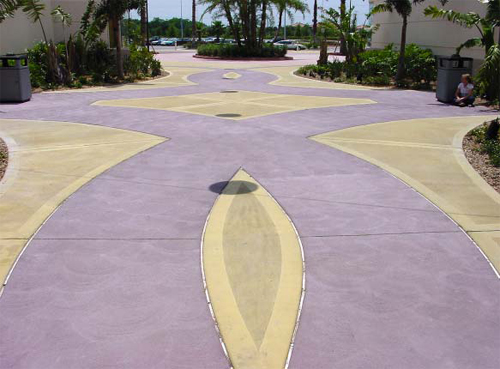
Thome says that some pozzolans can also have a negative affect on acid staining. “Pozzolans react with the calcium hydroxide produced by cement hydration. High-volume cement replacement with pozzolans can reduce the available calcium hydroxide in the concrete, which then will reduce the reactivity of chemical stains.”
Make admixtures work for you
When adding any admixture, purity and proper dosage rates are factors, says Murray Clarke of Delta Performance Products, a specialty concrete color pigment and amixture company. “Generally speaking, cleaner ingredients in concrete result in better color, regardless of the admixtures you’re using. Proper dosage rates of admixtures also play a critical role in concrete color, especially for long-term color performance.”
When higher-grade concrete in general is used, colors hold up better in the long term, he says. “That means using a ‘cleaner’ cement, making sure the aggregate and sand is clean and consistent, and knowing the effects admixtures can have on color. It really comes down to a matter of good, versus better, versus best.”
Whatever a contractor chooses regarding admixtures, water ratio, and quality of raw ingredients, a good method for achieving quality is test samples. “The key to pouring quality integrally colored concrete is to establish a baseline,” says Sullivan. “To really know what your color is going to look like in the end, you have to pour samples. Once you’ve established a baseline from your samples, mix consistency is the key.”
Finally, when you understand the effects of admixtures as well as you do the rest of your job parameters, you can better control your pour results. “In Southern California, the temperature often changes dramatically during the day,” says Smith. “Knowing this, we use the admixtures that we need during the hottest part of the day in the morning pours too – even though that can mean that the morning pours take longer to finish. It really comes down to controlling as many variables as you can.”


